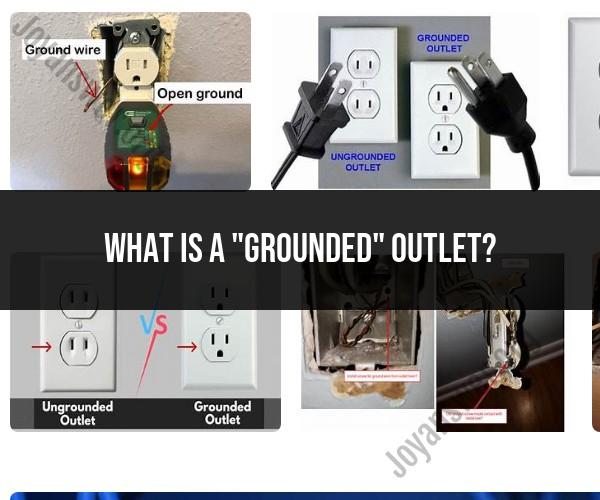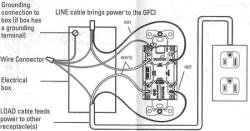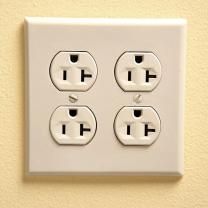What is a "grounded" outlet?
A grounded outlet, also known as a three-prong or earthed outlet, is a type of electrical outlet commonly used in homes and buildings to enhance electrical safety. It has three slots or holes for plugs: two vertical slots and a round hole beneath them. Each of these slots has a specific purpose:
Hot (Live) Slot: The shorter, left-hand slot is called the hot or live slot. It carries the electrical current from the power source to the connected device.
Neutral Slot: The longer, right-hand slot is the neutral slot. It carries the electrical current back from the device to the power source.
Grounding Hole: The round hole located below and between the two slots is the grounding hole. It is connected to the grounding system of the building.
The key feature that differentiates a grounded outlet from an ungrounded one is the presence of the grounding hole. This grounding system is designed to protect you and your electronic devices from electrical faults and reduce the risk of electrical fires and electric shock.
Here's how it works:
In normal operation, electrical current flows from the hot slot to the device and returns through the neutral slot without any issues.
In the event of a fault, such as a short circuit or a malfunction that causes the device's metal casing to become live, the grounding system comes into play.
If a fault occurs, the electricity will be directed into the grounding system through the third prong and the grounding wire. This grounding path provides a low-resistance route for the electrical current to follow, safely diverting it away from you and preventing electrical shocks.
Grounded outlets are essential for various appliances and electronics, particularly those with metal enclosures or exposed conductive parts, like washing machines, refrigerators, computers, power tools, and entertainment systems. The grounding feature helps ensure the safety of both the equipment and the people using them by preventing electrical hazards. Therefore, it's crucial to use grounded outlets for appliances and devices that require them and to ensure that your electrical system is properly grounded to maximize safety in your home or workplace.
1. Demystifying "Grounded" Outlets: What It Means for Electrical Safety
Grounded outlets are an essential safety feature for any home or business. They provide a safe path for electricity to flow if there is a fault in an appliance or wiring. This can help to prevent electrical shock, fires, and other hazards.
A grounded outlet has three slots: two vertical slots for the hot and neutral wires, and a round hole for the ground wire. The ground wire is connected to the metal frame of the outlet, and ultimately to the earth. This provides a safe path for electricity to flow if there is a fault.
Grounded outlets are required by law for all new construction, and they should be used wherever possible. If you have ungrounded outlets in your home, you should consider having them replaced by a qualified electrician.
Grounded Outlets Explained: Ensuring Secure Electrical Connections
Grounded outlets are designed to ensure the safety of people and property. They do this by providing a safe path for electricity to flow if there is a fault in an appliance or wiring. This can help to prevent electrical shock, fires, and other hazards.
Here is a more detailed explanation of how grounded outlets work:
- The hot wire carries electricity from the electrical panel to the appliance.
- The neutral wire carries electricity back from the appliance to the electrical panel.
- The ground wire provides a safe path for electricity to flow if there is a fault.
If there is a fault in the appliance or wiring, electricity may leak onto the metal frame of the appliance. If the appliance is not grounded, the electricity can flow through the person touching the appliance, causing an electrical shock. If the appliance is grounded, the electricity will flow through the ground wire back to the electrical panel, preventing electrical shock.
Grounded outlets are also important for fire prevention. If there is a fault in an appliance or wiring, and the appliance is not grounded, the electricity can flow through the walls of the home, starting a fire. If the appliance is grounded, the electricity will flow through the ground wire back to the electrical panel, preventing a fire.
Electrical Safety Basics: Understanding Grounded Outlets
Electrical safety is important for preventing accidents and injuries. One of the most important things you can do to stay safe is to use grounded outlets.
Grounded outlets are designed to protect you from electrical shock and fires. They do this by providing a safe path for electricity to flow if there is a fault in an appliance or wiring.
To use a grounded outlet, simply plug your appliance into the outlet. The ground wire in the outlet will be connected to the metal frame of the appliance, providing a safe path for electricity to flow if there is a fault.
If you have any ungrounded outlets in your home, you should have them replaced by a qualified electrician. Grounded outlets are an essential safety feature for any home or business.
Here are some additional tips for electrical safety:
- Never use appliances with frayed cords or damaged plugs.
- Avoid using appliances in wet or humid areas.
- Do not overload electrical outlets or circuits.
- Teach your children about electrical safety.
By following these tips, you can help to keep yourself and your family safe from electrical accidents and injuries.













